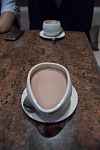The A77 is definitely a good buy if you're looking for something sturdy, with a good overall balance of features and performance. While the A77 is a slight disappointment in the noise handling department, it definitely makes up for it with the fast AF (especially if coupled up with one of Sony lenses that feature Super Sonic Wave Motors) and stellar video quality. We'd recommend buying the body only and saving the extra 30K (A77+16-105mm f/3.5-5.6 kit is for INR 99,999) and investing it in a nice lens, like a 50mm f/1.4 prime instead of a kit lens that suffers from poor optical quality.
The Sony SLT-A77 (or the Alpha 77, or the A77 or the God of all crops cameras as we might want to call it) is built on the tough DNA of the Konica Minolta for sure, but takes on its own ergonomics along with being infused with Sony’s unmatched technological know-how. The amount of incredible features the A77 packs is absolutely mind boggling (at one point, we wondered if pressing a button would make it transform into a mech or something. Didn’t happen though). There’s a few firsts, a few refinements of previously discarded technology and all of it plays rather well together. We got our eager hands on this puppy/beast (pick one!) and got cracking to see how well the various amazing features come together and whether they play well together or not.
Body and Ergonomics
With both Nikon and Canon switching over to polycarbonate as material of choice for the APS-C DSLRs, it was nice to see Sony sticking to the magnesium alloy goodness. The tough stuff definitely lends its ‘tough-stuff’ feel to the camera as you can feel the ‘cold-steel’ under your fingers. The areas where the hand grips the camera is wrapped in some generous rubberized material, but we love the feeling that our camera is made of stuff that doesn’t just break after taking a tumble (can’t say the same about the insides though, obviously). The camera surely is built solid, but all that magnesium alloy toughness is useless against the assault of the elements; specifically water and dust. Sony has generously tossed in that pro-grade weather sealing that’s normally reserved for the elite-pro-grade cameras. Yes, that’s right, pro-grade weather sealing on an APS-C DSLR. The sheer joy made us want to shoot with it standing under the shower, but we chose to exercise restraint.
The weather sealing isn’t all that sets this DSLR apart. The button layout favors one handed use, with all buttons on the back being placed on the right side of the screen. At first, they look like Sony might be trying to just cram everything in there, but after a few days’ worth of use, we realized just how well placed these buttons are. They were all well within the reach of our moderately sized thumb. The joystick at the back works adequately well to move the focus points around as well. There is a dedicated movie button that instantly starts recording video, which is a nice touch. Only the menu button finds a spot on the left of the viewfinder, but it isn’t inconvenient to access in any way.
Unconventional in DSLRs, Sony has added two horizontal dials, one on the back and one on the front of the hand grip to change aperture and shutter speed values, something Nikon users might be familiar with. The mode dial on the top left has a toothed rubber texture, which makes turning the dial a lot easier as it has a high amount of resistance. We welcome the heightened level of resistance on the dial as we have often experienced the mode dial changing positions when it was hanging off our shoulders (on several other cameras, not the A77).
-522-100.jpg) |
-522-100.jpg) |
-522-100.jpg) |
-522-100.jpg) |
-522-100.jpg) |
-522-100.jpg) |
-522-100.jpg) |
-522-100.jpg) |
-522-100.jpg) |
 |
The top LCD is quite rich in information (like most top LCDs) and is surrounded by the ISO, exposure bracketing, white balance and drive/timer buttons. There is even a button to toggle between dedicated liveview or viewfinder views, but it’s oddly placed on the rise of the flash, which makes reaching it with the thumb a little difficult. Expect to move the camera away from the eye to reach this function.
Features
The Sony SLT – A77 is infused with a whole load of juicy goodness. The A-77, at the time of announcement, was the first camera to feature a gorgeous 2.4 million dot screen as the viewfinder (electronic viewfinder). One might be inclined to think that Sony’s just throwing fancy features at the users without the actual need, but the EVF serves a crucial piece of tech in the larger scheme of things.
The A77 features an insane burst speed of 12 frames per second, all achieved thanks to the semi translucent mirror that replaces the typical mirror box in a DSLR. Typically, when you shoot, the mirror needs to be pulled up so the light from the lens can hit the sensor to form the image. Burst modes in conventional DSLRs are slower because there is a delay that gets factored in. Camera makers have spent obscene amounts of money in fine tuning the mirror box mechanism to achieve higher frames per second. Sony simply introduced the translucent mirror, effectively boosting the burst speed.
The one drawback of the translucent mirror is that it dims the light in the viewfinder significantly. That’s where the EVF comes in. It removes the dimly lit viewfinder and replaces it with a digital image being rendered through the A77’s liveview engine. The EVF isn’t without its fair share of issues though. Since the image is being digitally rendered, we noticed that any time we shot in relatively low light (around sunset and after), the image in the EVF became extremely noisy. Of course that noise is only due to the liveview engine boosting the display, but it makes reading the digital display a little difficult, especially in low light.

The A77 also uses a fully phase-detection based focusing system, which works better for this sort of a system. The phase detection chip sits on top of the translucent mirror, which feeds it light data constantly. Phase detections works better than classical contrast detection AF as it only needs one reading of the scene to determine where to focus, whereas contrast detection AF requires multiple readings, and hence, moved the lens through the entire focus range.
Another very handy feature Sony has thrown into the A77 is a three-way-swivel-tilt screen. The screen is a 921K dot screen employing Sony’s TruBlack technology which does indeed render images quite well. The screen’s versatility cannot be bound by the words we write to describe its effectiveness. Film-makers will especially appreciate the ways in which they can twist and turn the screen, in order to get angles which were previously a hassle not worth tackling.
Focussing System
The A77 uses a full Phase Detection based AF that does a great job thanks to the constant light stream provided by the translucent mirror. This not only helps with faster focussing, but even shows better tracking results when compared to similar cameras using contrast detect AF. If you’re a proud owner (or owner to be) of the A77, you will get 19 AF-points to play around with, 11 of which are cross type. Cross type AF points are sensitive in both horizontal and vertical orientations, and thus offer better focus locking and tracking that non cross-type AF points.
The AF system can be set in four configurations; Manual (MF), Single Shot (S), Continuous (C) and Automatic (A), all accessible through a dial on the bottom right (if you’re facing the lens mount) . The dial is a nice touch, as its one thing you won’t need to fumble with buttons for. As far as the AF performance of the A77 is concerned, we had no trouble whatsoever, in locking focus, in part, thanks to the built AF-illuminator lamp. We did feel the focus was a bit slow to lock on, but that was mostly a feature of the slow AF motor on the lens (the Sony 16-105mm f/3.5-5.6). Another problem we faced with the focus system was that when using the nav-stick at the back to switch focus points (while looking through the viewfinder), it took nearly half a second for the focus point to switch from the old one to the one adjacent to it. This sluggishness, in our opinion, really cripples the otherwise blazing fast AF system. Hopefully, a firmware update might fix the issue.
Visit page two, to read about the Sony Alpha 77's Image Quality, Video Performance, and Verdict…
Image Quality
There’s a lot at stake when you decide to pack in an obscene amount of pixels into an area as small as an APS-C sensor. The realm of 24 megapixels was something even the full frames stayed away from (at least at the time of announcement). Packing in this many pixels has always been a taboo due to fears of noise quality degrading too quickly. We figured it would be best to see if such effects existed for ourselves.
In our outdoors test, the Sony did well with respect to getting the exposures right. None of our shots felt like there was an exposure bias (towards shadows OR highlights), which left us a little surprised (pleasantly albeit) as we’ve never had a DSLR balance out exposures so well before. We also noticed that the 24 megapixel sensor resolves not just detail, but even dynamic range rather well.
We expected the performance of the camera to be good when shooting in good lighting conditions at nominal ISOs, so we decided to see what the images would look like at higher ISOs. We bumped up the ISO to 3200 and our consequent shots revealed something interesting. While the sensor was not generating any color noise, there was definitely a significant amount of grain. Now this grain wasn’t visible in preview mode, but when we looked at the photos at a 100%, it was surely there.
|
ISO 100
|
ISO 200
|
ISO 400
|
ISO 800
|
ISO 1000
|
|
ISO 1600
|
ISO 2000
|
ISO 3200
|
ISO 4000
|
ISO 5000
|
|
ISO 6400
|
ISO 8000
|
ISO 10000
|
ISO 12800
|
ISO 25600
|
Even our studio shots confirmed the presence of noise at ISO 3200. In shooting our standard test target, we found that the shadow areas were quick to develop chrominance and luminance noise. While ISO 3200 just showed signs of noise, which can easily be rectified using any noise reduction tool, higher ISOs were not so forgiving. Interestingly, ISO 6400 exhibited a slight color shift, with the image becoming quite warm on the top half of the frame. The same behavior was prevalent at ISO 12800 and ISO 16000 as well, only, in these cases, the color shift was applied to the entire image and the noise had reduced the images to grainy mess. We’d recommend caution when pushing the ISO levels over 3200, especially in low light. However, shots up to ISO 5000 can be salvaged using noise reduction, without any significant loss in detail.
The flash on the A77 is surprisingly better than most on-camera flashes we’ve come across. It has a guide number of 12 (at ISO 100), meaning the flash will have an effective range of about 8 feet (at aperture f/1.4). The range might not seem that impressive, but what is nice about the on board flash is that its illumination is quite even, and the presence of harsh shadows is almost negligible. Unfortunately, all is not peachy in the flash department. While using the stock 16-105mm lens (without a lens hood), we found that the combination cast a lens shadow when zoomed out all the way to 16mm. While the problem doesn’t really exist beyond 85mm, we still feel that the flash could have been designed to not cast such a shadow. With cameras like the Nikon D7000 or the Canon 60D, we didn’t face such problems.
 |
 |
 |
 |
 |
 |
 |
 |
 |
 |
 |
 |
 |
 |
 |
 |
 |
 |
 |
 |
 |
 |
 |
 |
 |
 |
 |
 |
Video
The A77 offer the ability to record full HD footage in either AVCHD format (1920×1080 at 60p,60i and 24p) or MP4 (1440×1080 at 30fps). There is a stereo mic built into the hinge of the flash which records audio pretty well, but unfortunately has a tendency to pick up on wind noise rather easily. The dedicated video button is great to quickly switch into video recording mode.
As good as the video quality is, unfortunately, making the most of the A77’s video system is a little tricky. There is no way to have full manual control over the shutterspeed and aperture while maintaining AF. Activating video recording in any of the PASM modes locks the camera in Program mode, meaning, you get full time autofocus, but no control over the exposures. In order to shoot manually, we had to switch to the dedicated video marker on the mode dial. We can’t figure out why Sony would not allow full time AF to be functional while using manual settings for video. So if you’re going to picking up the A77, know that there is a trade-off between AF and manual exposure for video.
What Else is There
The Alpha 77 is treading on the a territory which has been long been jointly dominated by the Canon 7D and Nikon D7000. The 7D from canon boasts a very impressive focus system with pro-grade tracking capabilities and has been the staple go-to camera for amateur film-makers on a budget. The Nikon D7000 has rivaled the 7D with better overall image quality (with its higher dynamic range and better color depth) and its much lower price point. However, the D7000 cannot match the 7D’s 8 frames per second burst mode.
The three 7’s (Canon 7D, Nikon D7000 and Sony SLT – A77) all share mighty impressive features. If you’re a megapixel nut, then the A77 is the obvious choice hands down. However, if you’re looking for a solid video performer, the 7D might be a better choice, despite the higher price point. The Nikon D7000 does best the other two in overall image quality though. Last but not the least, the A77 is the cheapest of the three (for body only) pricing in at INR 69,999, followed by the Nikon D7000 (INR 79,950) and with Canon 7D being the most expensive of all at INR 87,995. The Alpha does pack more bang for the buck when it comes to features, but the Canon 7D does offer a more solid performance.
Verdict
The Sony SLT – A77 is a monster of a DSLR no doubt. There some impressive firsts and equally astounding innovations packed in here, that seem to work beautifully together. It seems like Sony hasn’t held back one bit in infusing this semi-professional APS-C DSLR with pro grade features, all while keeping the price tag at a modest level.
The A77 is definitely a solid performer for the class it’s pitted into. A high resolution sensor that renders great detail, a mirror-shutter assembly that allows blazing fast burst speeds and a novel focusing system that works faster than the conventional Contrast Detection system makes the A77 a very well rounded semi-pro DSLR. We love the rugged build, the weather sealing and the nice dials. We love the ergonomics. What we didn't like was the mediocre noise performance, especially after seeing how the Nikon D3200 managed to keep noise at bay all the way to ISO 6400 while the Alpha was struggling at ISO 3200 (read our review). The lack of continuous AF while shooting video in Manual mode is quite disappointing, seeing as how Sony is trying to lure in amateur film-makers with the high quality video and the swivel-tilt-turn screen.
For a price of INR 69,990 (for body only), the A77 is definitely a good buy if you’re looking for something sturdy, with a good overall balance of features and performance. While the A77 is a slight disappointment in the noise handling department, it definitely makes up for it with the fast AF (especially if coupled up with one of Sony lenses that feature Super Sonic Wave Motors) and stellar video quality. We’d recommend buying the body only and saving the extra 30K (A77 16-105mm f/3.5-5.6 kit is for INR 99,999) and investing it in a nice lens, like a 50mm f/1.4 prime instead of a kit lens that suffers from poor optical quality.

Swapnil Mathur
Swapnil was Digit's resident camera nerd, (un)official product photographer and the Reviews Editor. Swapnil has moved-on to newer challenges. For any communication related to his stories, please mail us using the email id given here. View Full Profile



















